11.9.12 Pluck U
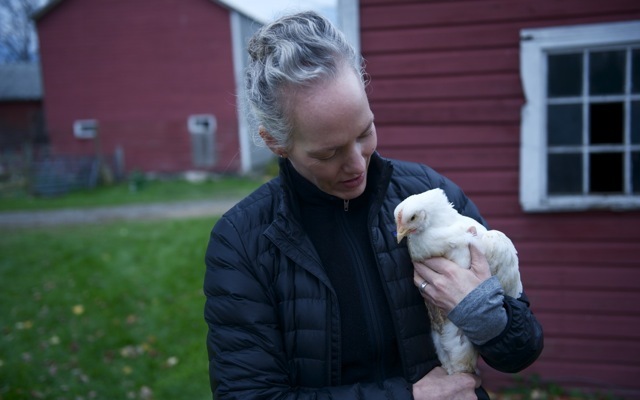
photos by gluttonforlife
Attention: This post contains some very graphic photos! If you are not prepared to see the actual process of a chicken being slaughtered and processed, read no further.
For those of you who eat chicken and would like to understand how it goes from being a living being to a nourishing food on your plate, please read on. The photos are not meant to distress or sensationalize, merely to document the steps necessary in a small, hands-on operation. I encourage you to familiarize yourself with this, as I'm hoping it may affect your desire to consume industrially raised and processed animals. I think it's really important to understand how the animals we eat are fed, treated and killed; to make every effort possible to ensure humane treatment; and to refuse to eat anything whose origins are uncertain. For a more thorough explication of my beliefs on this subject, go here.
For those of you who eat chicken and would like to understand how it goes from being a living being to a nourishing food on your plate, please read on. The photos are not meant to distress or sensationalize, merely to document the steps necessary in a small, hands-on operation. I encourage you to familiarize yourself with this, as I'm hoping it may affect your desire to consume industrially raised and processed animals. I think it's really important to understand how the animals we eat are fed, treated and killed; to make every effort possible to ensure humane treatment; and to refuse to eat anything whose origins are uncertain. For a more thorough explication of my beliefs on this subject, go here.
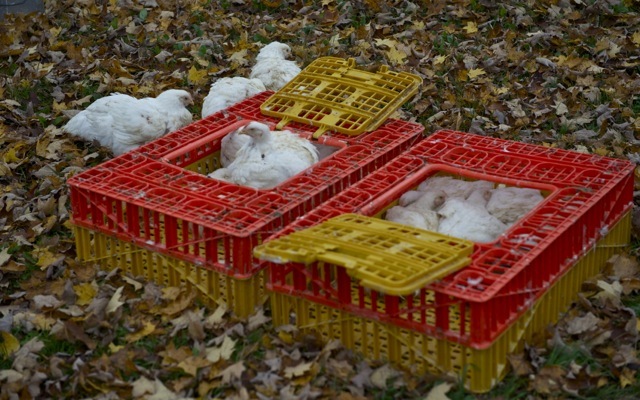
feathered nest
The lovely Jessica Applestone of Fleisher's, a butcher shop specializing in grass-fed and organic meats, with locations in Kingston, NY, and Park Slope, Brooklyn, invited me to attend a butchering workshop that included a visit to Meadow View Farm in New Paltz. There, under the tutelage of master butcher Hans Sebold, we were to learn how chickens are slaughtered and processed by hand, on a small scale. Then we would return to Fleisher's in Kingston for lunch and a butchering demonstration by resident meat guru Joshua Applestone.
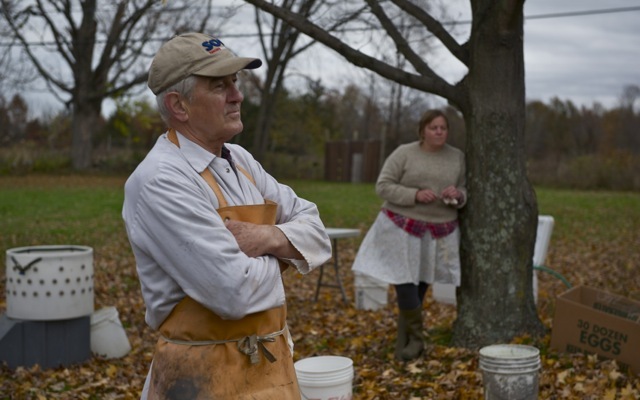
Hans on
Hans Sebold is an old school butcher from Bavaria who has worked with many large-scale meat operations, and was for decades an instructor at the Culinary Institute of America. He is a wealth of knowledge, wisdom and compassion. I was so impressed with his gracious manner and the way he taught us to consider the chickens and the act of killing them. The word "butcher" has such negative connotations, and yet through history it has been a sacred position. G has told me about his experiences photographing the slaughter of hundreds of animals during Eid, and how the butchers would chant prayers and stroke the animal until it was calm and totally relaxed before carefully slitting its throat. Violence does not have to be part of the equation, though Hans did point out that some animals (chickens, rabbits) give up their lives much more easily than others (pigs, cows).

down the chute
There was a very simple set-up for killing the chickens, and Hans walked us through the steps, one by one. There were about 10 of us, and we each selected a chicken, held it and stroked it until it was calm.
The next step is to lower the chicken head-first down a metal cone; three of these had been nailed to the side of a small barn where we were working. The chicken did not squawk or struggle at all, which would probably have made it much harder than it already was for me. I had never before intentionally killed anything except mosquitoes and that is truly in self defense. Wait, I did pith my own frog in biology class in high school. Anyway, the point is, I was not approaching this blithely.
The next step is to lower the chicken head-first down a metal cone; three of these had been nailed to the side of a small barn where we were working. The chicken did not squawk or struggle at all, which would probably have made it much harder than it already was for me. I had never before intentionally killed anything except mosquitoes and that is truly in self defense. Wait, I did pith my own frog in biology class in high school. Anyway, the point is, I was not approaching this blithely.
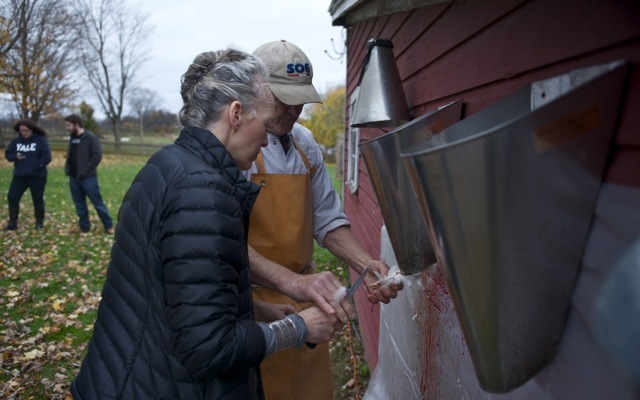
making the cut
Hans was with me every step of the way, as I was very frightened by the idea that I might somehow hurt the chicken. Ridiculous, I know, since I was killing it, but I do believe there is a right way to inflict the least possible suffering.
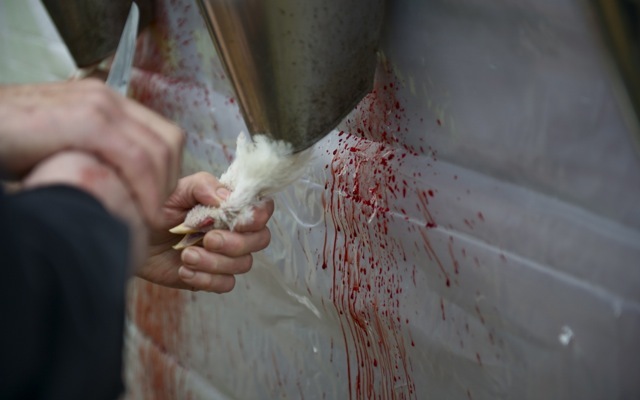
graphic detail
It's all done very swiftly. A single sweep of the sharp blade not only kills the bird, but cleanly severs its head from the neck. The upside down position allows the blood to drain out quickly. As you probably know, the body continues to jerk around after the bird is dead ("running around like a chicken without its head") and this is a bit disconcerting. It is what it is. If you want to nourish yourself with its flesh, then honor the animal by understanding what it goes through.

water bath
The rest of the process is facilitated by a couple of simple tools. The headless birds are dunked into a pot of hot water, which loosens their feathers.
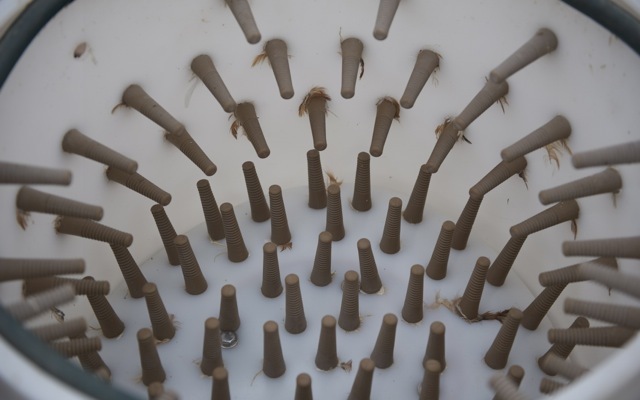
the bird spins for a few moments in this device to remove the feathers
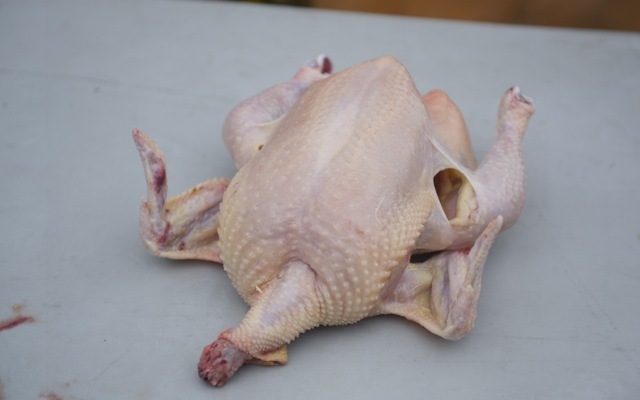
blessed bird
Once denuded and laid out on a cutting board, the chicken starts to look much more like what we're used to seeing at the market.
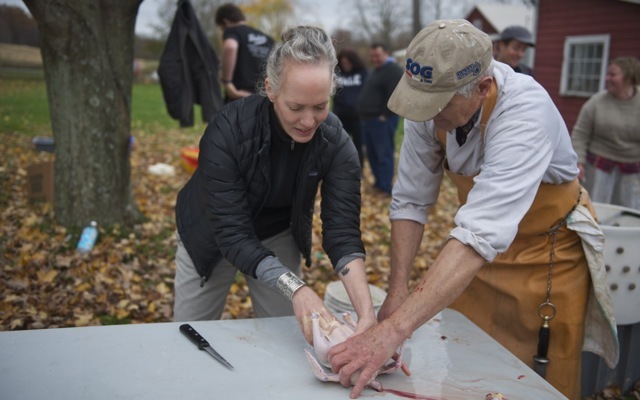
no guts, no glory
The next step is exactly what you might imagine: you simply plunge your hands into the still-warm cavity and scoop out the internal organs in one go. We were all a bit nervous about puncturing the bowel, intenstines or bile duct. As you can see, Hans was a great coach.

G gets the scoop

killing field
We killed and cleaned about a dozen birds in a very short time. It was quite a calm and quiet experience, not nearly as heart-wrenching as I had anticipated. My chicken had lived a quality life, 8 weeks of pecking for bugs and eating a mix of greens and grain on a lovely farm. I had a few moments of silence with it, both before and after the killing, trying to be mindful of its sacrifice and to internally express my gratitude.
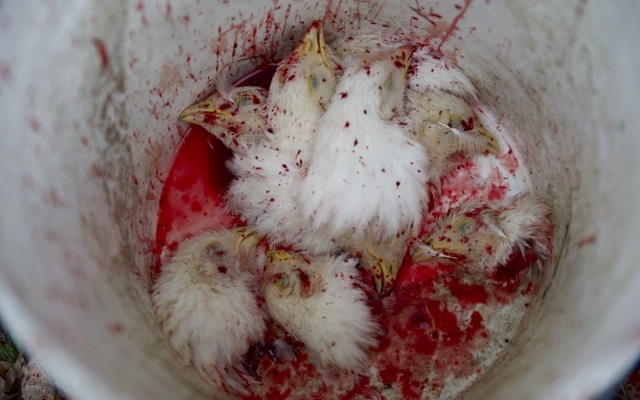
uneasy sight
This sight did give me pause. I was sad that the heads were being discarded. I would have liked to take home a whole chicken—head, feet and all—to make the richest, most nutritious soup. I do not take for granted the meat I eat, but I will think about it even more carefully now. I will not waste a scrap. Every bite will count. And I will do everything in my power to know, without doubt, that the hands that bring me my food are as loving and caring as my own. Or I will simply choose to go without.






15 Comments